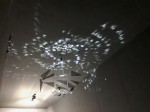Seph Li’s multimedia-based art piece “Cosmos” uses reflective mirrors and physics theories to reveal the mysteries of our universe – or universes.
Li, a design media arts alumnus, will display “Cosmos” at the Shanghai Art Fair, which opens Thursday and runs through Sunday at the Shanghai World EXPO & Convention Center. The piece ruminates on the multiverse theory – the notion that multiple universes exist simultaneously – through a light sculpture.
Li constructed the installation piece “Cosmos” using light and a series of reflective surfaces. The surfaces reflect a slowly moving flashlight beam, producing images of pixels in space. Li said the mirrors are arranged in a nebular shape and also represent a star in the vast cosmos. When the flashlight moves, it alters the shape of the artificial cosmos.
“Depending on the angle of the mirror, sometimes you can see the reflections and at another angle you can’t see it,” Li said. “I was intrigued by making an installation involving moving images that can shift what you see by where you are standing.”
Li created the piece in 2014 after reading a post on the science blog Nautilus and finding inspiration in the theoretical physics presented. The article explained that when the equations for general relativity and quantum theory are merged together, the element for time gets canceled out of the final equation.
The idea is part of a longstanding theory by some physicists who have suggested there may be two existing universes whose opposing movements counteract one another. “Cosmos” incorporates the strains of scientific thought to present a mysterious double universe reflected on nearby wall space.
Werner Thöni, the owner of the Werner Thöni Artspace gallery in Barcelona, Spain, where Li created and displayed “Cosmos,” said he was impressed with how concisely Li rendered such a complex scientific theory.
“What was really interesting for me was how he was able to poetically speak about the concept,” Thöni said.
In both the physics theories and his own artwork, Li said a viewer’s perception is dependent on physical positioning. Since people cannot see the movement of their own universe, Li said they would only be able to see the flow of time if they stood inside the cosmos looking out at the universes. In the same way, viewers must physically shift positions while looking at the installation to discover the reflected images in “Cosmos.”
“Visitors can walk into the area where they see the virtual images floating in the air and they have to walk close enough to it to see the other whole hidden universe,” Li said.
Peter Lunenfeld, a design media arts professor who was a part of a faculty committee that reviewed Li’s thesis works for his master’s degree, said the mirrors and reflected images in “Cosmos” behave as a metaphor for virtuality versus the physical existence of objects.
“The question is, the images on the ceiling which we can see and experience – how much of that is reality and does that have as much reality as actual starlight?” Lunenfeld said.
Lunenfeld said Li’s art bridges the gaps between the virtual and the real, fine art and media-based art.
“His pieces try to massage between the real and the virtual by creating environments in real space which allow a portal into a virtual space,” Lunenfeld said. “(“Cosmos”) is a perfect example of how (Li) is constantly trying to connect worlds that aren’t normally connected.”
The concept and objects were originally digitally designed and later 3-D printed into tangible pieces. Thöni said the conversion of computerized information into physical reality amplifies the sensation of the unknown, both in the cosmos and in the creation of the work itself.
“He created something in a computer and then made it in real space, calculated exactly with all the angles to create a spiral nebula form,” Thöni said, “It’s like some kind of miracle.”
Gallery visitors who saw “Cosmos” exhibited in Barcelona reacted to its meticulous setup with surprise, wonder, awe and curiosity, Thöni said. Li’s artwork took a step into an experimental territory that most commercialized artists do not venture into, he said.
“Normally we don’t see commercial artists doing something different like (“Cosmos”),” he said. “The reaction was asking what it was about, what it meant and ‘What is that?’”
Digital and media-based art is slowly being accepted into the realm of public art as interest in interactive experiences rises, Li said.
“People think traditional art doesn’t have enough interactivity … yet they think digital art is alienating them because it is still digitally fabricated,” Li said. “This could be the time when the public is getting more into the interactivity of the digital.”
Lunenfeld said Li’s art utilizes the most current technologies in order to address global audiences by touching on a common chord of human experience and the question of what lies beyond the known world.
“It’s an artwork that uses as one of its multiple points of entry … something that we all care deeply about, which is what happens to us, the sense of ourselves or even the sense of our souls when we look up into a dark night sky,” Lunenfeld said.
